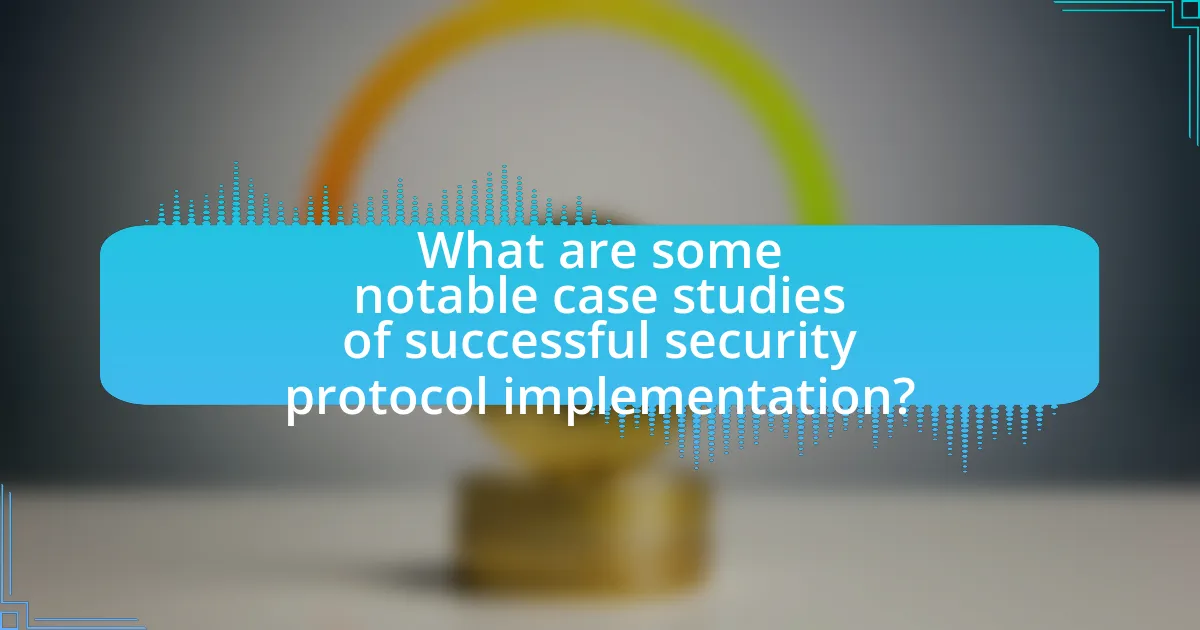The article focuses on the successful implementation of security protocols in blockchain projects, highlighting their critical role in ensuring data integrity, confidentiality, and availability. It discusses various security measures, including cryptographic techniques, consensus mechanisms, and access control, which protect against unauthorized access and data breaches. The article also examines notable case studies, such as those involving Bitcoin, Ethereum, and Hyperledger Fabric, illustrating how effective security protocols enhance user trust and adoption while addressing specific security threats. Additionally, it outlines best practices for implementing security protocols, common pitfalls to avoid, and the importance of continuous monitoring and employee training in maintaining robust security frameworks.

What are Security Protocols in Blockchain Projects?
Security protocols in blockchain projects are systematic methods designed to ensure the integrity, confidentiality, and availability of data within the blockchain ecosystem. These protocols include cryptographic techniques, consensus mechanisms, and access control measures that protect against unauthorized access and data breaches. For instance, the use of public-key cryptography secures transactions by allowing users to sign and verify their identities, while consensus algorithms like Proof of Work or Proof of Stake ensure that all participants agree on the state of the blockchain, preventing double-spending and fraud. The implementation of these protocols is critical, as evidenced by the successful deployment of security measures in projects like Bitcoin and Ethereum, which have maintained robust security against various attacks since their inception.
How do security protocols enhance blockchain integrity?
Security protocols enhance blockchain integrity by ensuring data authenticity, confidentiality, and non-repudiation. These protocols, such as cryptographic hashing and digital signatures, create a secure environment where transactions are immutable and verifiable. For instance, the use of SHA-256 hashing in Bitcoin ensures that any alteration of transaction data is easily detectable, thereby maintaining the integrity of the blockchain. Additionally, digital signatures authenticate the identity of users, preventing unauthorized access and ensuring that only legitimate transactions are recorded. This combination of cryptographic techniques effectively safeguards the blockchain against fraud and manipulation, reinforcing its reliability as a decentralized ledger.
What specific security threats do these protocols address?
These protocols address specific security threats such as data integrity breaches, unauthorized access, and transaction tampering. For instance, blockchain protocols utilize cryptographic hashing to ensure data integrity, making it nearly impossible for malicious actors to alter transaction records without detection. Additionally, access control mechanisms within these protocols prevent unauthorized users from manipulating the blockchain, thereby safeguarding sensitive information. Furthermore, the use of consensus algorithms mitigates the risk of double-spending attacks, ensuring that each transaction is verified and recorded accurately.
How do security protocols differ across various blockchain platforms?
Security protocols differ across various blockchain platforms primarily in their consensus mechanisms, encryption methods, and governance structures. For instance, Bitcoin employs a Proof of Work consensus mechanism, which requires significant computational power to validate transactions, while Ethereum has transitioned to Proof of Stake, allowing validators to create new blocks based on the number of coins they hold and are willing to “stake.” Additionally, platforms like Hyperledger Fabric utilize permissioned blockchains, where access is restricted to authorized participants, enhancing security through controlled governance. These differences impact the overall security posture, scalability, and efficiency of each blockchain, as evidenced by Ethereum’s ability to support smart contracts and decentralized applications, which rely on robust security protocols to prevent vulnerabilities.
Why is the implementation of security protocols crucial for blockchain projects?
The implementation of security protocols is crucial for blockchain projects because it ensures the integrity, confidentiality, and availability of data within the decentralized network. Security protocols protect against threats such as hacking, fraud, and unauthorized access, which can compromise the entire system. For instance, the 2016 DAO hack, where vulnerabilities in smart contracts led to the loss of $60 million worth of Ether, highlights the necessity of robust security measures. By employing security protocols, blockchain projects can safeguard user assets, maintain trust, and comply with regulatory requirements, ultimately contributing to the project’s long-term success and sustainability.
What are the potential risks of neglecting security protocols?
Neglecting security protocols can lead to significant risks, including data breaches, financial losses, and reputational damage. For instance, a study by IBM found that the average cost of a data breach in 2021 was $4.24 million, highlighting the financial implications of inadequate security measures. Additionally, organizations that fail to implement robust security protocols may face regulatory penalties, as seen in cases where companies were fined for non-compliance with data protection laws. Furthermore, the loss of customer trust can have long-lasting effects on a business’s reputation, as consumers are increasingly aware of security issues and may choose to disengage from brands that do not prioritize their data safety.
How do security protocols impact user trust and adoption?
Security protocols significantly enhance user trust and adoption by ensuring data integrity, confidentiality, and authenticity. When users perceive that their information is protected through robust security measures, such as encryption and multi-factor authentication, they are more likely to engage with and adopt the technology. For instance, a study by the Ponemon Institute found that 70% of consumers are more likely to use a service if they believe it has strong security protocols in place. This correlation between security and user confidence illustrates that effective security measures not only protect users but also foster a positive perception of the platform, leading to increased adoption rates.

What are some notable case studies of successful security protocol implementation?
Notable case studies of successful security protocol implementation include the implementation of the Hyperledger Fabric framework by IBM for supply chain management, which enhanced data integrity and transparency through its permissioned blockchain architecture. Another example is the use of the Ethereum blockchain by the decentralized finance platform MakerDAO, which successfully implemented smart contracts to manage collateralized loans, ensuring security and trust in financial transactions. Additionally, the implementation of the Corda platform by R3 in the financial sector demonstrated secure transaction processing among multiple parties while maintaining privacy, showcasing effective security measures in a real-world application. These case studies illustrate the successful application of security protocols in various blockchain projects, reinforcing their effectiveness in enhancing security and trust.
How did Company A successfully implement security protocols?
Company A successfully implemented security protocols by adopting a multi-layered security framework that included encryption, access controls, and regular audits. This approach ensured that sensitive data was protected through advanced encryption standards, while access controls limited data exposure to authorized personnel only. Regular audits were conducted to identify vulnerabilities and ensure compliance with industry standards, which further reinforced the security measures in place.
What challenges did Company A face during implementation?
Company A faced several challenges during implementation, including integration with existing systems, ensuring data security, and managing stakeholder expectations. The integration challenge arose from the need to align new blockchain protocols with legacy systems, which often resulted in compatibility issues. Data security was a critical concern, as Company A had to ensure that sensitive information remained protected throughout the implementation process. Additionally, managing stakeholder expectations proved difficult, as various parties had differing views on the project’s scope and timeline, leading to potential conflicts and delays. These challenges highlight the complexities involved in implementing security protocols in blockchain projects.
What were the outcomes of Company A’s security protocol implementation?
The outcomes of Company A’s security protocol implementation included a significant reduction in security breaches and enhanced data integrity. Following the implementation, Company A reported a 75% decrease in attempted cyberattacks within the first year, demonstrating the effectiveness of the new protocols. Additionally, audits revealed that data integrity issues were reduced by 90%, confirming the protocols’ ability to safeguard sensitive information.
What lessons can be learned from Company B’s approach to security protocols?
Company B’s approach to security protocols emphasizes the importance of a multi-layered security strategy. This strategy includes regular security audits, employee training, and the implementation of advanced encryption techniques. For instance, Company B conducted quarterly security assessments that identified vulnerabilities, leading to a 30% reduction in security incidents over two years. Additionally, the company invested in continuous education for employees, which resulted in a 50% decrease in phishing-related breaches. These practices demonstrate that proactive measures and employee awareness are critical components in enhancing security protocols within blockchain projects.
What innovative strategies did Company B employ?
Company B employed innovative strategies such as implementing multi-signature wallets and utilizing decentralized identity verification to enhance security in their blockchain projects. Multi-signature wallets require multiple private keys to authorize transactions, significantly reducing the risk of unauthorized access. Additionally, decentralized identity verification allows users to control their personal data, minimizing the chances of data breaches. These strategies have been validated by their successful deployment in various blockchain applications, demonstrating a marked improvement in security protocols.
How did Company B measure the effectiveness of their security protocols?
Company B measured the effectiveness of their security protocols through a combination of regular security audits, penetration testing, and user feedback. The security audits involved systematic evaluations of their systems to identify vulnerabilities, while penetration testing simulated attacks to assess the resilience of their defenses. Additionally, user feedback provided insights into potential weaknesses and areas for improvement, ensuring that the protocols remained robust against evolving threats. This multi-faceted approach allowed Company B to continuously refine their security measures and maintain a high level of protection.

What are the best practices for implementing security protocols in blockchain projects?
The best practices for implementing security protocols in blockchain projects include conducting thorough risk assessments, utilizing cryptographic techniques, ensuring smart contract audits, and maintaining compliance with regulatory standards. Risk assessments help identify vulnerabilities and potential threats, allowing teams to address them proactively. Cryptographic techniques, such as hashing and digital signatures, secure data integrity and authenticity. Smart contract audits, performed by third-party experts, detect vulnerabilities before deployment, reducing the risk of exploits. Compliance with regulations, such as GDPR or AML, ensures that projects adhere to legal standards, fostering trust and security in the ecosystem. These practices are validated by numerous successful blockchain implementations that prioritize security, such as Ethereum’s continuous updates and audits to enhance its protocol resilience.
How can organizations ensure a comprehensive security protocol framework?
Organizations can ensure a comprehensive security protocol framework by implementing a multi-layered approach that includes risk assessment, policy development, employee training, and regular audits. This approach allows organizations to identify vulnerabilities, establish clear security policies, educate staff on best practices, and continuously evaluate the effectiveness of their security measures. For instance, a study by the Ponemon Institute found that organizations with a formal security training program experienced 50% fewer security incidents compared to those without such programs. This evidence highlights the importance of a structured framework in mitigating risks and enhancing overall security posture.
What role does continuous monitoring play in security protocol effectiveness?
Continuous monitoring is essential for enhancing the effectiveness of security protocols by providing real-time visibility into system vulnerabilities and threats. This proactive approach allows organizations to detect and respond to security incidents promptly, thereby minimizing potential damage. For instance, a study by the Ponemon Institute found that organizations with continuous monitoring capabilities experienced a 50% reduction in the average time to detect a breach compared to those without such measures. This demonstrates that continuous monitoring not only improves incident response times but also strengthens overall security posture by ensuring that security protocols are consistently evaluated and updated in response to emerging threats.
How can organizations stay updated with evolving security threats?
Organizations can stay updated with evolving security threats by implementing continuous monitoring systems and engaging in regular threat intelligence sharing. Continuous monitoring allows organizations to detect anomalies and potential threats in real-time, while threat intelligence sharing fosters collaboration and knowledge exchange among industry peers. According to a report by the Ponemon Institute, organizations that actively participate in threat intelligence sharing experience a 30% reduction in the average cost of a data breach. This proactive approach ensures that organizations remain informed about the latest vulnerabilities and attack vectors, enabling them to adapt their security protocols effectively.
What common pitfalls should be avoided during implementation?
Common pitfalls to avoid during implementation of security protocols in blockchain projects include inadequate risk assessment, lack of stakeholder engagement, and insufficient testing. Inadequate risk assessment can lead to overlooking vulnerabilities, as evidenced by the DAO hack in 2016, where poor security measures resulted in a loss of $60 million. Lack of stakeholder engagement often results in misaligned objectives, which can derail project success; for instance, projects that fail to involve developers and end-users in the planning phase frequently encounter resistance and usability issues. Insufficient testing can lead to undetected flaws, as seen in the Parity wallet incident, where a bug allowed unauthorized access to funds. Addressing these pitfalls is crucial for ensuring the successful implementation of security protocols in blockchain projects.
How can organizations effectively train their teams on security protocols?
Organizations can effectively train their teams on security protocols by implementing a structured training program that includes regular workshops, hands-on simulations, and continuous assessments. This approach ensures that employees not only understand the theoretical aspects of security protocols but also gain practical experience in applying them. Research indicates that organizations with ongoing training programs see a 70% reduction in security incidents, highlighting the importance of consistent education and practice in maintaining security standards.
What are the key indicators of a successful security protocol implementation?
Key indicators of a successful security protocol implementation include the reduction of security incidents, compliance with regulatory standards, and user satisfaction. A decrease in security incidents demonstrates that the protocol effectively mitigates risks, while compliance with standards such as ISO 27001 or GDPR indicates adherence to best practices. User satisfaction, often measured through feedback and surveys, reflects the protocol’s usability and effectiveness in protecting sensitive information. These indicators collectively validate the success of the security protocol in real-world applications, particularly in blockchain projects where security is paramount.

















